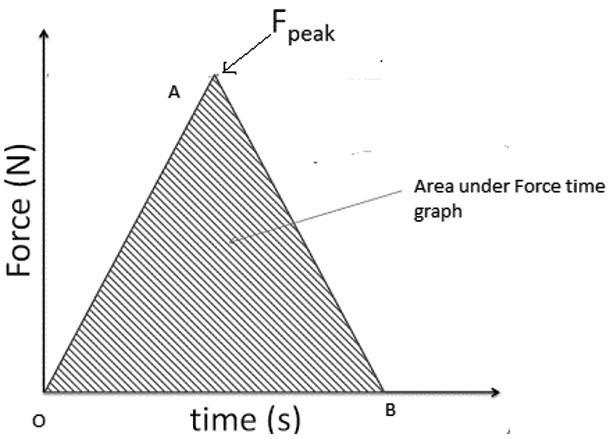
The area under a force time graph gives acceleration.
A. True
B. False
Answer
579k+ views
Hint: Area under the force-time graph gives the impulse acting on the body.
Complete step by step solution:
Let us consider a Force time graph shown below with peak of force as \[{F_{peak}}\]. The x-axis Force makes the curve OAB such that a triangle OAB is formed.

If we calculate area of triangle OAB,
Area of shaded portion \[ = {\text{ }}\raise.5ex\hbox{$\scriptstyle 1$}\kern-.1em/
\kern-.15em\lower.25ex\hbox{$\scriptstyle 2$} {\text{ }}Base \times Altitude\]
\[ = \raise.5ex\hbox{$\scriptstyle 1$}\kern-.1em/
\kern-.15em\lower.25ex\hbox{$\scriptstyle 2$} {\text{ }}T \times {F_{peak}} = Formula{\text{ }}of{\text{ }}Impulse = \] Change in momentum of body
Hence, Area under the force-time graph gives the impulse (or change in momentum) acting on the body.
Thus, the above statement that the area under the Force time graph gives acceleration is false.
Additional Information:
1. The dimensional formula of impulse is the same as that of momentum \[\left[ {M{\text{ }}L{\text{ }}{T^{ - 1}}} \right]\]. In SI the unit of impulse is Ns or\[kgm{s^{ - 1}}\].
2. An accelerated motion is always due to a force. The acceleration produced by a force in the motion of a body depends only upon its mass.
Note: Impulse received during an impact is equal to the product of average force during the impact and the time for which the impact lasts and is also equal to the change in momentum produced during the impact.
Complete step by step solution:
Let us consider a Force time graph shown below with peak of force as \[{F_{peak}}\]. The x-axis Force makes the curve OAB such that a triangle OAB is formed.

If we calculate area of triangle OAB,
Area of shaded portion \[ = {\text{ }}\raise.5ex\hbox{$\scriptstyle 1$}\kern-.1em/
\kern-.15em\lower.25ex\hbox{$\scriptstyle 2$} {\text{ }}Base \times Altitude\]
\[ = \raise.5ex\hbox{$\scriptstyle 1$}\kern-.1em/
\kern-.15em\lower.25ex\hbox{$\scriptstyle 2$} {\text{ }}T \times {F_{peak}} = Formula{\text{ }}of{\text{ }}Impulse = \] Change in momentum of body
Hence, Area under the force-time graph gives the impulse (or change in momentum) acting on the body.
Thus, the above statement that the area under the Force time graph gives acceleration is false.
Additional Information:
1. The dimensional formula of impulse is the same as that of momentum \[\left[ {M{\text{ }}L{\text{ }}{T^{ - 1}}} \right]\]. In SI the unit of impulse is Ns or\[kgm{s^{ - 1}}\].
2. An accelerated motion is always due to a force. The acceleration produced by a force in the motion of a body depends only upon its mass.
Note: Impulse received during an impact is equal to the product of average force during the impact and the time for which the impact lasts and is also equal to the change in momentum produced during the impact.
Recently Updated Pages
Master Class 11 Economics: Engaging Questions & Answers for Success

Master Class 11 English: Engaging Questions & Answers for Success

Master Class 11 Social Science: Engaging Questions & Answers for Success

Master Class 11 Biology: Engaging Questions & Answers for Success

Class 11 Question and Answer - Your Ultimate Solutions Guide

Master Class 11 Business Studies: Engaging Questions & Answers for Success

Trending doubts
What is meant by exothermic and endothermic reactions class 11 chemistry CBSE

1 Quintal is equal to a 110 kg b 10 kg c 100kg d 1000 class 11 physics CBSE

What is periodicity class 11 chemistry CBSE

Explain zero factorial class 11 maths CBSE

What is a periderm How does periderm formation take class 11 biology CBSE

What are porins class 11 biology CBSE




